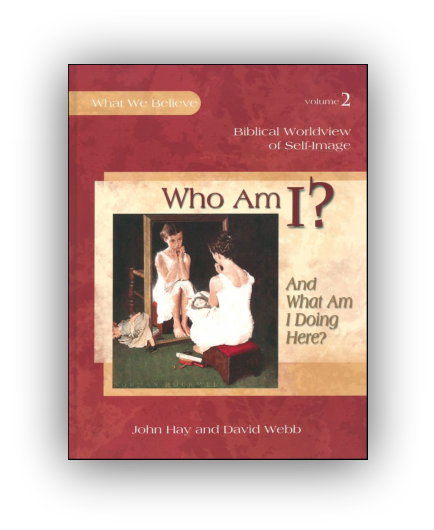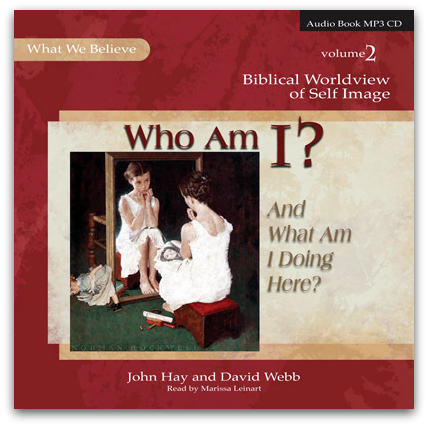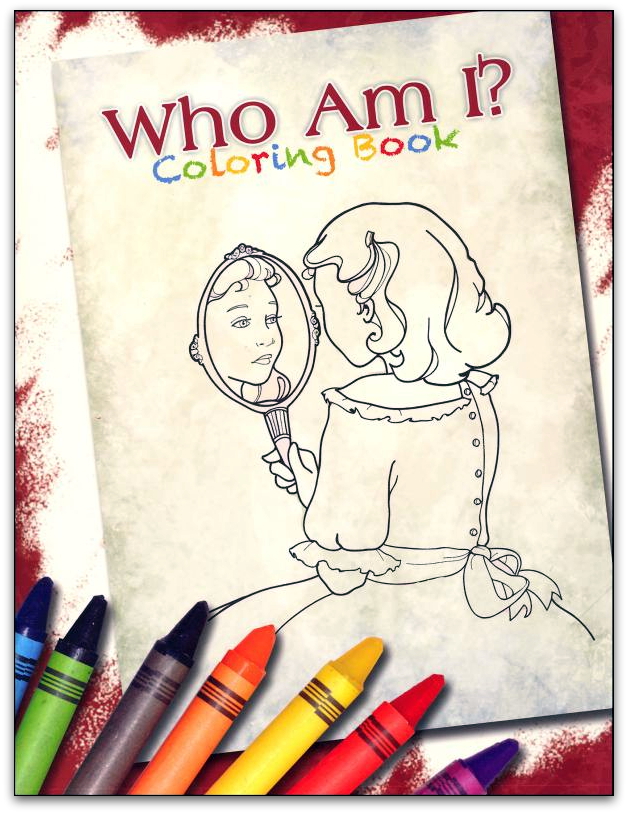So far, I have not met an Apologia publication that I was not impressed with! And this one is no exception!
This past month I have had the opportunity to review a Bible curriculum published by Apologia entitled Who Am I? And What Am I Doing Here?, by John Hay and David Webb (Volume 2 of their series, "What We Believe: Biblical Worldview of Self-Image").First of all, the materials are top quality. The main book is a beautifully bound hard-back book (above left). Available, also, is a beautiful spiral-bound Notebooking Journal for the student to compile on their own (above right). [The photos are not to scale. The books are approximately the same size.] In addition, available, also, is the content of the book on MP3-CD (below, left), as well as a corresponding coloring book (below, right).
I understand the Old Schoolhouse Homeschool Crew had the opportunity to review Volume I of this series last year. Unfortunately, I wasn't on the crew last year, and I didn't have that opportunity. (I always hate to jump into a series anywhere but at Volume 1, but that's just me...) However, Volume 1 is not a prerequisite for doing Volume 2.
Who Am I? What Am I Doing Here?
Bible Curriculum: $39.00 [
Audio Book (MP3): $19.00 [
Notebooking Journal, spiral-bound: $24.00 [
Coloring Book: $8.00 [
This curriculum is geared toward students ages 6-14, but is adaptable to many ages. It can very easily adapt to be used as a family curriculum for family worship time, or it is suitable to have each student set up with their own set of materials so they can use it independently.
The beginning of the book lays out a suggested plan for using the material. It suggests working on each Lesson being spread out over three weeks, working on the material during two sessions each week. There are eight lessons to be spread out over three weeks each, taking a total of 24 weeks, so this curriculum can be done over approximately 2/3 of the school year (a school year being 36 weeks long). This method is very compatible with Charlotte Mason methodology. To cover material in small increments, and then have a break before working on the material some more, gives the student time to absorb the content, think about it, "chew the cud" mentally, if you would. I have found, in my own home schooling experience, that this method is more effective than having large quantities of material covered in a very short time, studied, and then tested. My older kids say they have forgotten much of what we studied using that other method.
Now, content-wise, I'm loving Who Am I? And What Am I Doing Here?. And, in addition to loving the content and the format in general, I am also learning myself! I love the feel of the books in my hands. I can really work with the size of type in the book. (Some other reading I've been doing lately has such small print I'm about ready to get out a magnifying glass!) I like the glossy nature of the pictures. I like the balance, the size of the content segments, etc. In some ways, though, I don't like that. I mean, it's very handy in some subjects, the way the day's lesson says, "Start here", and "Stop here". That is an easy format, but not having that format gives more flexibility. Both formats have their place. This one works, but for me to get through the curriculum in a year I can see that I, personally, will need to input on my lesson planner things like: Week 1, Tuesday, do "this"; Thursday, do "this"; Week 2... etc. I know otherwise I will have trouble staying on track. That's why the materials that just list 160 lessons for the year work better for me. But this one is so good, I know I'll take the time to set up my lesson planner, because it will be so worth it. (In other words, I haven't yet had this material long enough to go through the entire curriculum with my son, so it will be in his future.)
Content -- From the very first lesson, I was questioning the correctness of some of the things I was reading. Now, granted, I am a product of the public school system. In addition, I graduated high school over 35 years ago. (Yes, I really did.) So, believe it or not, some of the things I actually managed to retain from my public education are no longer true. For instance, the first story in the book, in Lesson 1, is about Russia. When I was a student, Russia was the U.S.S.R (United Socialist Soviet Republic). Also known as the Soviet Union, the U.S.S.R. was dissolved in 1991 (16 years after I graduated high school), and I never learned much about it at the time, nor did I teach my older children about it. So, reading this story, things in my brain were screaming, "No! That's not true! That's not correct..." I didn't say anything to my son, but instead, when we were done with school for the day I went to the internet and did some research on Russia to learn that, yes, the book is correct, it is called Russia (I had thought "Russia" had dissolved), and Russia is
This curriculum seems like it would be suitable to all students. Visual students will like holding the book, reading it, looking at the pictures, diving into the notebooking journal, etc. Auditory students and emerging readers will like having the book's CD to listen to as they follow along in the book. Tactile learners and others will enjoy working on the notebooking journal and the coloring book. (I can't remember... Did I hit all the learning styles?)
The good, the bad, and the ugly:
So, here is where I point out all the particulars about things I liked, didn't like, and specifics about the materials.
- I love the format of this Volume 2 selection. I think the personal Journal is fabulous. I think the textbook is high quality.
- I loved having the book on CD. I found it difficult to get through the introduction, like my eyes were glazing over and scanning and I found it difficult to focus, but when I popped the CD into the player I got right through the material, was able to focus on it, and followed the content. I know it is very helpful for emerging readers to be able to hear an audio book while they follow along in the hard copy. That being said, the voice on the CD was ...different... I couldn't quite figure it out. Is it computer generated? Is it someone with a different accent? Someone for whom English is not their first language? I just couldn't place it, but the pronunciations are slightly different. And at times it caused me to be distracted from the content while my mind wandered trying to answer the above questions in my head...
- I love that the book and the CD give a code for getting more course materials. When you follow the book's directions and go to the given link for the book extras, enter the password given to correspond to the curriculum, it uncovers a weblink full of wonderful extras, chapter by chapter, to use as you work your way through the book. It includes teacher helps, notebooking pages, and links to PDF downloads of a section called "House of Truth", which is the terminology Apologia uses for the materials they have put together to help the student build their own Biblical world view, 36 links illustrating the house of character God desires to build in each one of us, with our foundation on the rock of God's word. Very cool stuff, but not something I would likely print out, but lots of potential for use with your student in an "on screen" format, or projector format using a program like Power Point.
- I didn't like that the beautiful cover is... so... "girly"-looking. I mean, it's a beautiful cover, a Norman Rockwell even, but it's a girl. I have a 12 year old son. This material is intended for boys OR girls, but the boys don't want their Bible curriculum book set to all have a picture of a girl in a frilly dress looking in the mirror... I mean, my thought was that, if they could manage it, they should have one cover version for boys and one for girls, or a cover that is more generic for either a boy or a girl. The coloring book is even more girly. The illustrations, even on the pages where the subject is strictly a man and/or a boy, are so soft and girly... Not very masculine or anything. I don't know how else to describe them. Fine for a girl. I can't test this one on my son, anyway -- he never liked coloring in the first place, so asking him would not provide a balanced opinion.
***********************************
This has been a TOS Homeschool Crew Review. I received these materials for free from the publisher in exchange for my honest review.





Loved reading your review. And thanks for the positive comments. We actually asked ourselves if we should go with the Girl in Mirror cover since it is clearly more feminine than masculine. When we considered the whole series, we kept it since volume 3 has a cover the boys will love - David and Jonathan. ~Davis Carman (President, Apologia)
ReplyDeleteWell, my son is enjoying the content when I read it aloud, but when I asked him to consider the journal and take a look at its content, he wouldn't even touch it. I have a lovely friend who's daughter is just going to love it, though. When we finish with the materials I will pass it along to bless them.
ReplyDeleteThanks for the wonderful quality of your products!
Thanks for putting the things you didn't like in your review. I like to know the good and the bad.
ReplyDelete